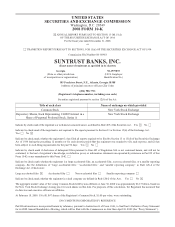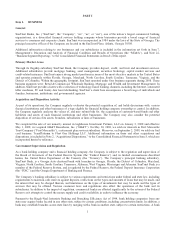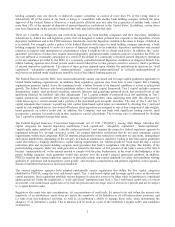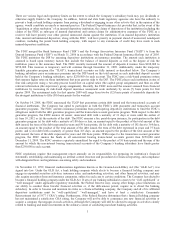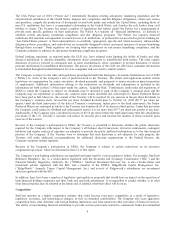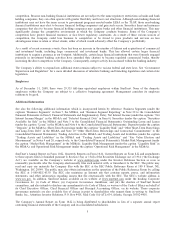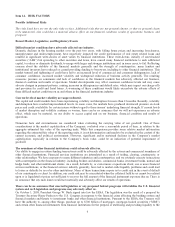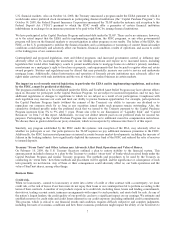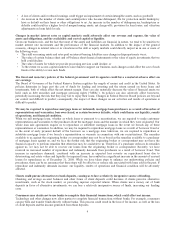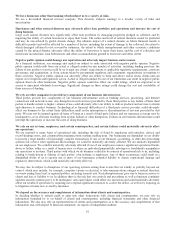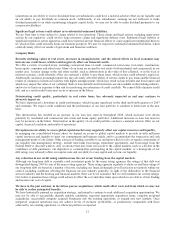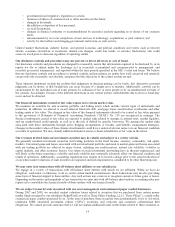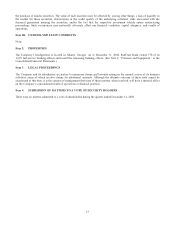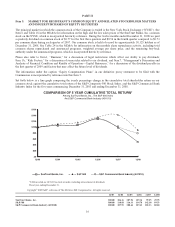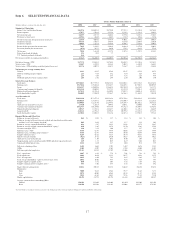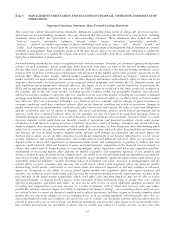SunTrust 2008 Annual Report Download - page 21
Download and view the complete annual report
Please find page 21 of the 2008 SunTrust annual report below. You can navigate through the pages in the report by either clicking on the pages listed below, or by using the keyword search tool below to find specific information within the annual report.• A loss of clients and/or reduced earnings could trigger an impairment of certain intangible assets, such as goodwill;
• An increase in the number of clients and counterparties who become delinquent, file for protection under bankruptcy
laws or default on their loans or other obligations to us. An increase in the number of delinquencies, bankruptcies or
defaults could result in a higher level of nonperforming assets, net charge-offs, provision for loan losses, and valuation
adjustments on loans held for sale.
Changes in market interest rates or capital markets could adversely affect our revenue and expense, the value of
assets and obligations, and the availability and cost of capital or liquidity.
Given our business mix, and the fact that most of the assets and liabilities are financial in nature, we tend to be sensitive to
market interest rate movements and the performance of the financial markets. In addition to the impact of the general
economy, changes in interest rates or in valuations in the debt or equity markets could directly impact us in one or more of
the following ways:
• The yield on earning assets and rates paid on interest bearing liabilities may change in disproportionate ways;
• The value of certain balance sheet and off-balance sheet financial instruments or the value of equity investments that we
hold could decline;
• The value of assets for which we provide processing services could decline; or
• To the extent we access capital markets to raise funds to support our business, such changes could affect the cost of such
funds or the ability to raise such funds.
The fiscal and monetary policies of the federal government and its agencies could have a material adverse effect on
our earnings.
The Board of Governors of the Federal Reserve System regulates the supply of money and credit in the United States. Its
policies determine in large part the cost of funds for lending and investing and the return earned on those loans and
investments, both of which affect the net interest margin. They can also materially decrease the value of financial assets we
hold, such as debt securities and mortgage servicing rights (“MSRs”). Its policies can also adversely affect borrowers,
potentially increasing the risk that they may fail to repay their loans. Changes in Federal Reserve Board policies are beyond
our control and difficult to predict; consequently, the impact of these changes on our activities and results of operations is
difficult to predict.
We may be required to repurchase mortgage loans or indemnify mortgage loan purchasers as a result of breaches of
representations and warranties, borrower fraud, or certain borrower defaults, which could harm our liquidity, results
of operations, and financial condition.
When we sell mortgage loans, whether as whole loans or pursuant to a securitization, we are required to make customary
representations and warranties to the purchaser about the mortgage loans and the manner in which they were originated. Our
whole loan sale agreements require us to repurchase or substitute mortgage loans in the event we breach any of these
representations or warranties. In addition, we may be required to repurchase mortgage loans as a result of borrower fraud or
in the event of early payment default of the borrower on a mortgage loan. Likewise, we are required to repurchase or
substitute mortgage loans if we breach a representation or warranty in connection with our securitizations. The remedies
available to us against the originating broker or correspondent may not be as broad as the remedies available to a purchaser
of mortgage loans against us, and we face the further risk that the originating broker or correspondent may not have the
financial capacity to perform remedies that otherwise may be available to us. Therefore, if a purchaser enforces its remedies
against us, we may not be able to recover our losses from the originating broker or correspondent. Recently, we have
received an increased number of repurchase and indemnity demands from purchasers as a result of borrower fraud. This
increase in repurchase demands, combined with an increase in expected loss severity on repurchased loans due to
deteriorating real estate values and liquidity for impaired loans, has resulted in a significant increase in the amount of accrued
losses for repurchases as of December 31, 2008. While we have taken steps to enhance our underwriting policies and
procedures, there can be no assurance that these steps will be effective or reduce risk associated with loans sold in the past. If
repurchase and indemnity demands increase, our liquidity, results of operations and financial condition will be adversely
affected.
Clients could pursue alternatives to bank deposits, causing us to lose a relatively inexpensive source of funding.
Checking and savings account balances and other forms of client deposits could decrease if clients perceive alternative
investments, such as the stock market, as providing superior expected returns. When clients move money out of bank
deposits in favor of alternative investments, we can lose a relatively inexpensive source of funds, increasing our funding
costs.
Consumers may decide not to use banks to complete their financial transactions, which could affect net income.
Technology and other changes now allow parties to complete financial transactions without banks. For example, consumers
can pay bills and transfer funds directly without banks. This process could result in the loss of fee income, as well as the loss
of client deposits and the income generated from those deposits.
9


